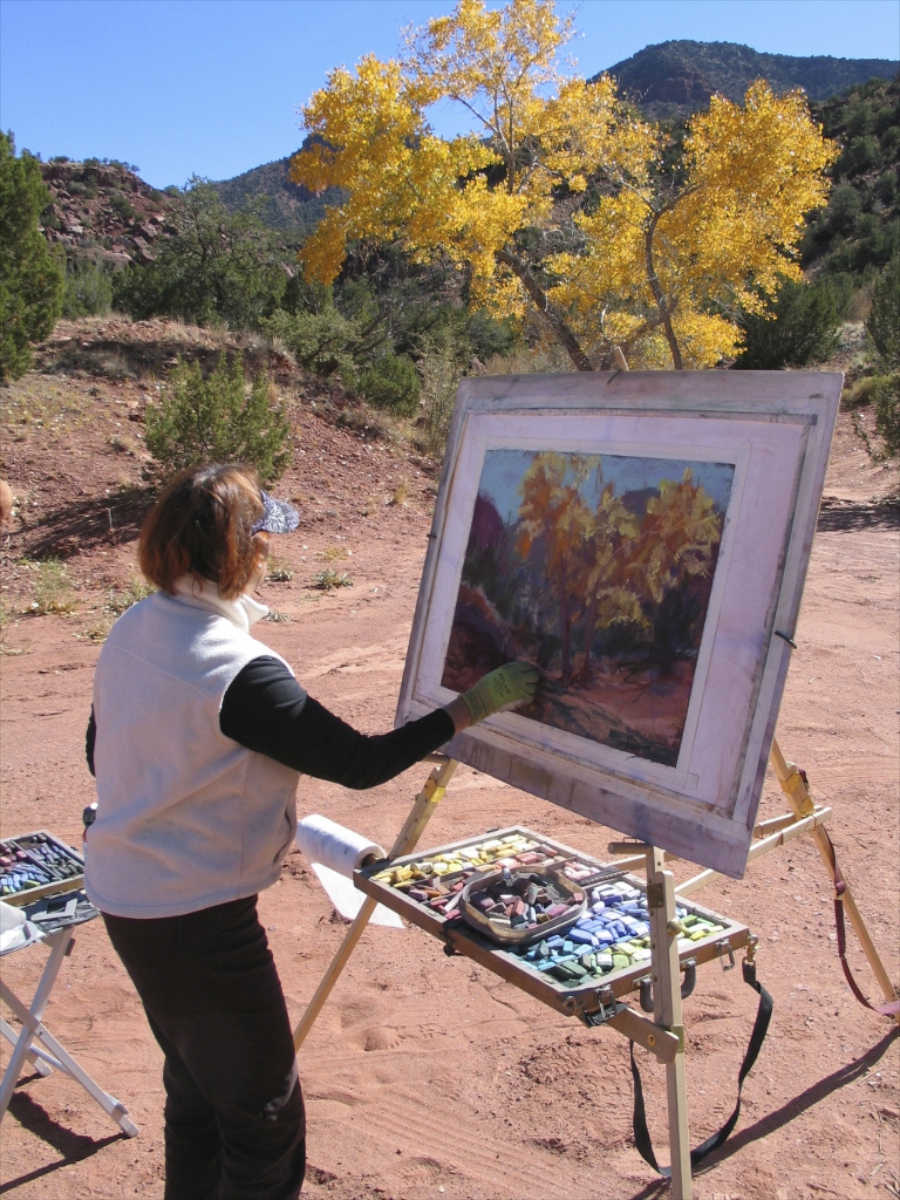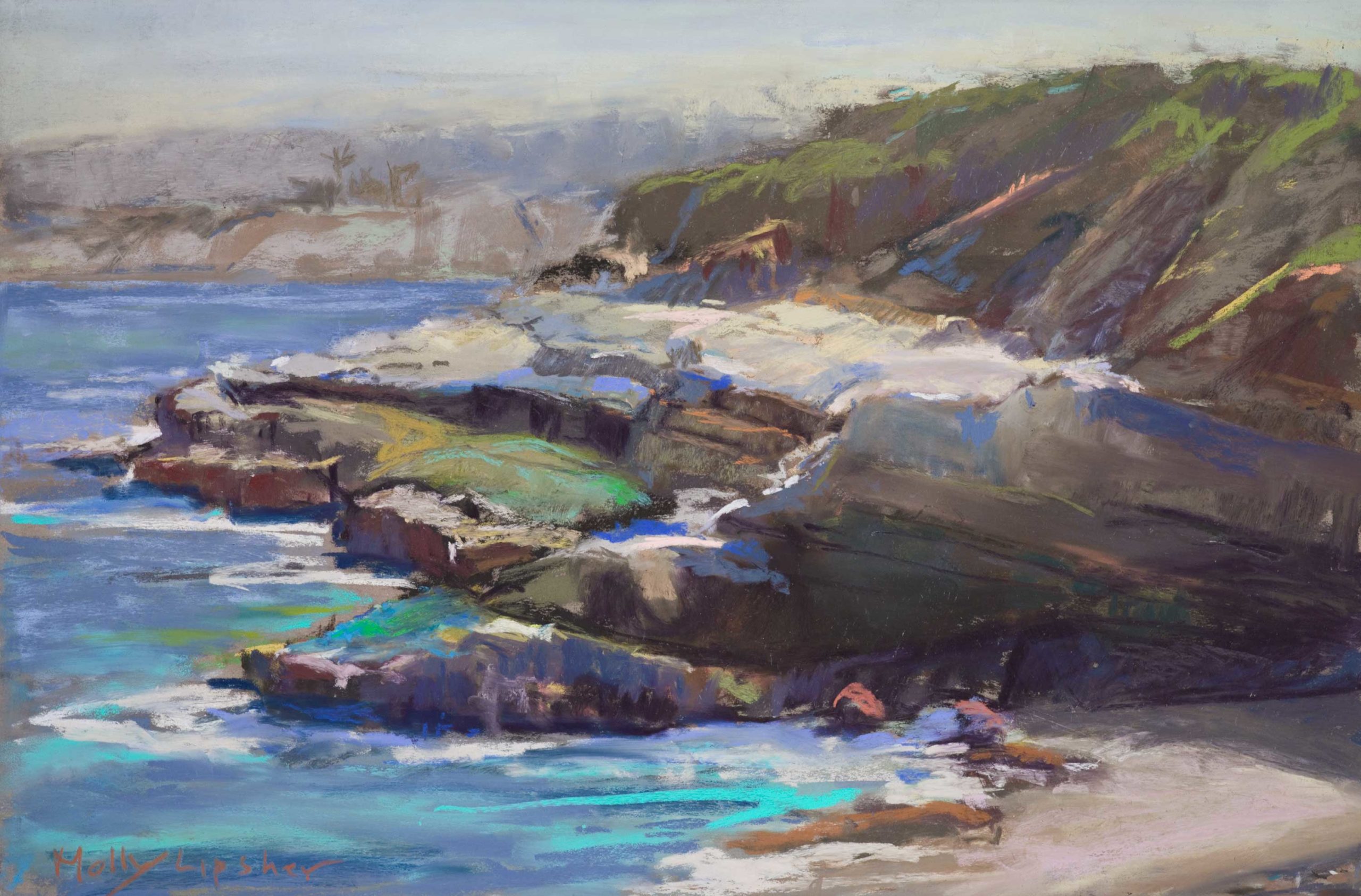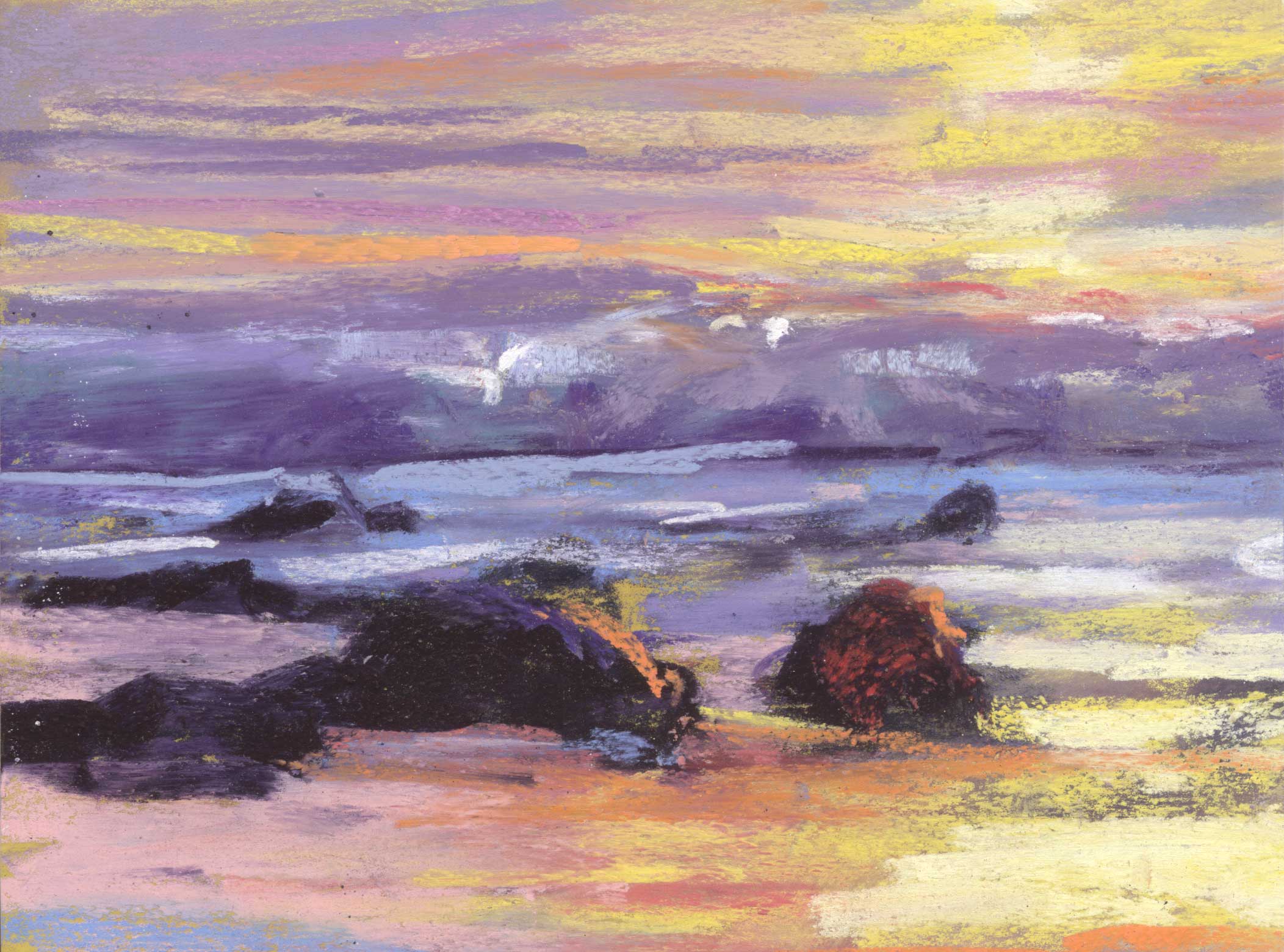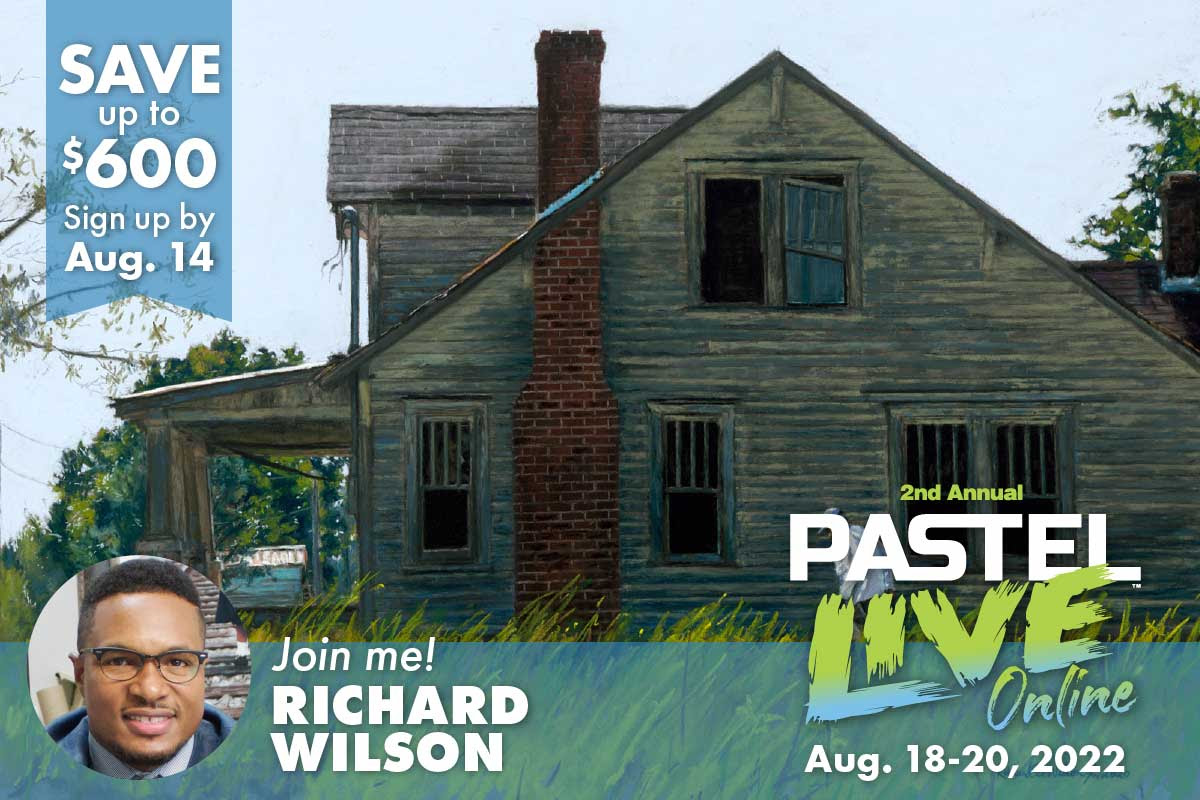On Painting with pastels > Molly Lipsher finds pastel the perfect medium for capturing the light, colors, and textures of the Western landscape.
A move to California around 2003 changed everything for classically trained studio painter Molly Lipsher. Having lived in New York City and worked primarily from the figure, the artist found that the Western landscape sparked a new direction in her work and her painting process. Here she talks about going from living as a tough city dweller to braving floods, gale–force winds, and even bears in her quest to capture the inspiring new scenery in her favorite medium, pastel.

Kelly Kane: How did you get started painting en plein air?
Molly Lipsher: When I moved to California, I was instantly overcome with the untamed beauty of the West — the great deserts; mountains; rugged coastlines; and long, unobstructed views that could be found within a few hours’ driving time. It was all so different from the short views, urban vistas, and cultivated landscapes that I knew from home.
I had never camped much, but was compelled to explore these new places by immersing myself in them for extended periods of time, dwelling in the solitude and quiet while plein air painting. I became a pretty avid explorer, learning how to tent camp and eventually outfitting a cargo van as a primitive camper. I found the harsh environments exhilarating. For years following, I painted exclusively outdoors, intensely inspired by the entire experience of being on location.
While thrilling, certain aspects were also daunting, especially having to be on the road so much of the time. I spent a number of years painting plein air works in traditional sizes, but as time went on I wanted to make a bigger statement, so the additional challenge of creating what would ordinarily be considered studio-sized pieces ensued on location.
At the same time, I also became more motivated to paint landscapes in the studio, but to do so I had to find a way to recreate the experience of being outdoors as much as possible. I purchased a better camera; learned how to edit my existing gray, flat photos by increasing the color nuances; and acquired a large screen on which to view the photos. The screen was so large, in fact, that I almost felt like I was standing on location. This process gave me the tools to utilize the extensive collection of photos I had taken while in my favorite places. So now I do both plein air and studio landscape paintings in all sizes.
Editor’s Note: “Spend 3 Days Learning From 30 Of The World’s Best Pastel Artists And You’ll Improve Faster and Better Than You Would By Attending Any Art School In America!” This Is An Investment In Your Future As An Artist… And It Starts Right Here: PastelLive.com!
How do you feel working outside has made your paintings better?
The incredible variation in the qualities of light across the viewing field is so exciting, and observable only when plein air painting. On location, it’s obvious that the quality, intensity, and color of light changes, often in a gradation from the sky to the horizon line, and from east to west as the distance from the sun changes across the scene. Objects in the landscape create reflected, dappled, and filtered light, further changing the observable qualities of the light we see — it’s never exactly the same in any two places in the scene.
One of the primary mistakes I see in beginner and intermediate painters’ work is monotonous light. It’s almost impossible to see these nuances from a photo. The ability to pick up on the subtle variations has to be learned and ingrained in one’s practice by painting on location. Only then can the principles effectively be applied in studio work. While it takes much practice to be cognizant of these variances and nuances of light, once you gain awareness — even if you can’t see it at all times — you can apply the knowledge to greatly enhance your paintings.
Apart from light, what are the qualities in the landscape that most inspire you?
I prefer places that are primitive, almost primordial, with few or no human artifacts. Over the years, I have returned again and again to New Mexico, the Eastern Sierra, and the Anza-Borrego Desert, just to name a few. I also am attracted to places where the colors are more vibrant, which has resulted in a preference for painting in arid climates and in some higher elevations where the light doesn’t have too blue of a cast.

How would you describe a perfect day painting en plein air?
Perfect conditions for me are bright clear skies, minimal wind, no bugs, and no bears.
In my recent series of paintings, I have focused on fleeting moments of dramatic light, such as sunsets and sunrises, flashes, and glares. And even though I’m inspired by the drama of painting toward the beginning or end of the day, in certain circumstances I don’t adhere to what we have been told are optimal conditions. Though the contrasts from shadows may be less prominent midday, I find the extreme glare bouncing off objects in the landscape at this time to be compelling. It dazzles the eye, and it’s fun to try to capture that quality of light.
Do you typically like to finish paintings on site, or do you bring them back to your studio for touchups?
As a plein air painter, I found it very difficult to finish paintings in the studio for the longest time. If they didn’t get finished on location, they often didn’t get finished at all. At a certain point in my plein air progression, I was primarily interested in the brevity of stroke that expressed the gestural aspect of the scene, which I saw as its primal energy. Whenever I tried to finish those pieces in the studio, the freshness and energy would be ruined.
As I became more interested in the nuances of light, it was more natural for me to finish works in the studio, because the paintings were generally taken to a greater level of finish than my earlier pieces. It does, however, seem to take an inordinate amount of time to complete work in the studio, compared to how quickly and effectively I can finish paintings on location with the actual scene in front of me.
Do you ever return to a site over the course of several days to complete a painting? If so, what are the challenges of doing that, and how do you overcome them?
I love painting large outdoors, often around 20 x 30 inches, which almost always requires a couple of days on location. For me, the challenges stem from the fact that I may be camping solo in a remote area with no amenities. If the weather or atmospheric conditions don’t cooperate, I’ll sometimes not be motivated to stick it out until the desired conditions return. Those pieces may or may not get finished in the studio.
I also find my own mood changes, and what I’ve experienced one day won’t feel the same as another day. I won’t paint with the same frame of reference, which can confound the results. What helps for me is to attempt the larger paintings in locations where I have painted before — where I understand the color palette, rock formations, and foliage well, so I can work more quickly to finish a piece.

What makes pastels perfectly suited to plein air painting?
Since there’s no mixing, pastels offer a relatively quick setup compared to wet mediums, and allow a fast, intuitive approach to the painting. This is especially useful in plein air when light conditions are rapidly changing, and also very handy for painting in timed events such as quick draws.
Conversely, what are the challenges of painting with pastels on location?
The primary difficulties are the weight and size of the pastels and the boxes I carry them in. If I’m working large, I find I need full sticks for adequate mark making. Although it’s possible to modify colors with glazing and layering, I generally want to have the exact colors I need, so it can be quite a haul. For smaller paintings, half or quarter sticks and a portable box suffice.
Wind and rain can also ruin pastels and damage the painting in progress, while some other mediums are more tolerant. If I must paint in the rain, I set up a tarp or umbrella; and if I really want to capture a scene in the wind, I’ll hunker down low with my pastel box on the ground. If I can get my car to the location, I sometimes paint from between two open doors to block the wind. Mostly, I just tend to avoid these types of conditions.
Because of the way I travel, I have nonetheless experienced some unavoidable conditions — gale force winds that raged so intensely one night that it broke the metal poles and flattened my tent while I was in it, mother bear and cub visitations to my campsite, hail, rain, and floods. Obviously, I’ve survived them all, but I know I benefited from a touch of ignorance about the risks, and the inflated self-perception that because I was from New York I would be a champ in the face of adversity (my actual response when warned not to camp in Wyoming: “Grizzlies, schmizzlies, I’m from New York!” which now is a little embarrassing, but funny to recall).
What’s in your standard pastel plein air toolkit?
I use a wide variety of brands and products. My main trove includes Terry Ludwig, Great American, and Diane Townsend pastels. Additionally, I use other brands for specific tasks. I apply Schmincke pastels, which are the softest and most concentrated sticks, primarily for specific details, including to accentuate a focal point with pure color.
I use harder pastels, such as Nupastels and a vintage Grumbacher set, to sketch and to glaze over passages completed with softer pastels. I love the Sennelier line of iridescent pastels and sometimes use them when I want to accentuate a detail or passage. I also occasionally use Giraults, which have a thinner profile and save space when working on location. Each brand has something different to offer, and once acclimated to a particular brand, I’m not sure it’s so important what you’ve chosen. The brand will, however, determine what type of painting surface best accommodates the particu-lar texture of the pastels.
My primary surface is a 56-inch roll of 600-grit UArt, since it can be cut as needed for large and non-standard sizes. Additional papers of choice include Art Spectrum’s Colourfix and Canson Mi-Tientes Touch in a variety of warm and cool colors, which accelerate the plein air process by providing the equivalent of an underpainting.
For larger works, I have both a Take It Easel and a heavy-duty tripod, which I use with a Heilman Medium pastel box. For smaller works, I favor a Double Sketchbox or Backpack Heilman box with a lighter-duty tripod. I use Heilman’s easel attachment, which fits into pre-drilled holes in their boxes.
What’s next for you? Are there new places you’re going to visit or new series you want to tackle?
I’d like to paint the Northern Lights on location, and am looking forward to a trip to Sweden’s Arctic Circle. I feel that my work is transitioning to a more abstract realm, with my interest moving toward painting fields of light rather than objects in the landscape. I’m also interested in exploring other mediums more rigorously to increase my versatility, though I will always favor the intensity, beauty, and pure color of pastels.
Related Article about Molly Lipsher:
Miniatures Offer Options: The Benefits of Painting Small Works
Related Event:
Visit EricRhoads.com to find out all the amazing opportunities for artists through Streamline Publishing, including:
– Online art conferences such as Plein Air Live
– New video workshops for artists
– Incredible art retreats
– Educational and fun art conventions, and much more.
> Subscribe to Plein Air Today, a free newsletter for artists
> Subscribe to PleinAir Magazine so you never miss an issue







I’d like to know more about how the particular brand dictates or suggests a certain surface: “The brand will, however, determine what type of painting surface best accommodates the particular texture of the pastels.”
A lot of it depends on how you apply the paint- do you create no layers, thin layers, thick layers, or press down hard or gently? There is an effect created by the balance between the softness of the sticks, the amount of texture on the paper, and your individual manner of application. It’s a matter of trial and error, and then determining which combination works best for what you are intending to create. I tend to press down very hard on the sticks, for example, and if I’m using a very textured paper, it completely eats up the sticks so quickly, and fills in all the grit of the paper so I can’t apply more layers. So, I tend not to use extremely gritty paper. You just have to play around with it, and paint enough so that you get to know how it all tends to work together. Hope that helps.